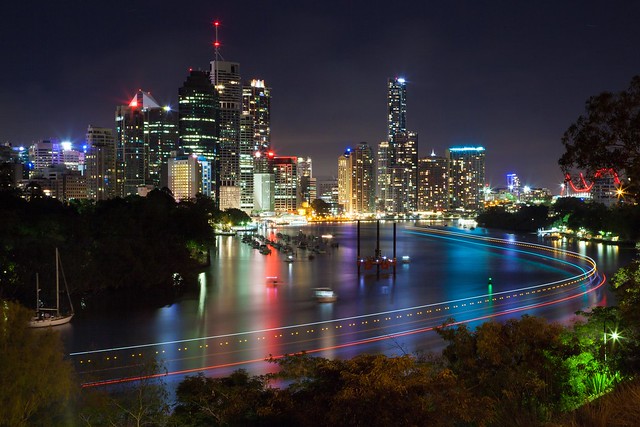Have you ever tried to take a photo at night, outside, and it came out terribly? Perhaps you were on vacation and saw a postcard of cars whizzing by the Eiffel Tower, streams of light from the headlights in the foreground and the beautiful monument in the background. But when you tried to replicate the image, it was a far cry from what you envisioned.

“Ferry Light Trails” captured by Andrew Sutherland
There’s a reason for this. Night photography follows the same rules as any other photograph. That is, when an image is not taken using the general principles of photography, errors occur. Photography literally means, writing with light. If you don’t have enough light, or you don’t take the available light that you do have into account, you’re going to end up with rubbish photographs.
Here’s how to take great photos at night. Obviously, like with anything in photography, this is subject to various techniques. My technique for getting the shot may be different than others.
- Use a Tripod. I cannot stress this enough. In fact, as your photography skills grow, you will find that it is almost impossible to live without a tripod.
- Learn the manual settings on your camera. Know what shutter speed and aperture have to do with it. I’ve written an article on that also.
- Use a shutter release cable. These can be purchased at almost any good camera store. This will help with the camera vibration. It’s a small cord that can be attached to your camera, which allows you to take your finger off of the shutter release button, dampening vibration. Wireless remotes or the camera’s built in timer are other options.
- Use the mirror lockup function. DSLRs have a mirror, which, when you look through the viewfinder, reflects the image from the lens, so you can see what the lens is seeing. This causes vibration in the camera and can lead to blurry photos. Mirror lockup reduces camera vibration.

Photo by Sudheer G; ISO 100, f/8.0, 40-second exposure.
Okay, you have all the ingredients to make a great photo at night. Here’s how to put them all together:
Using your tripod, set up the shot which you think is pleasing to the eye. Set your camera to manual and set your mirror lockup function.
Use your in-camera light meter to determine what the best exposure will be. For instance, if you’re using an aperture of /f11 and an ISO of 100, you might get a reading of 2 seconds, or more. Here is where it gets interesting; the slower your shutter speed, the more action you’re going to record. Meaning, if you have a shutter speed of 10 seconds and within those 10 seconds 35 cars speed by your image, in your foreground, you’re going to capture a lot of streaming lights. This is quite a nice effect in night photography. The shutter speed and aperture will work together to give you the sort of image you’re looking for. Maybe you don’t care about streaming lights, then don’t worry about having super long shutter speeds.
One thing to make a note of is that the aperture really doesn’t matter here. Anything above, say, f/5.6 is fine for night photos. You’re not too concerned with capturing depth of field in the foreground and background. This is especially true for cityscapes. I have shot at f/2.8 at times and had very similar results as f/11, because everything I’m shooting is so far away. My lens is focused at infinity to be exact.
Also, ISO speeds of 100 or 200 are fine here. In fact, they’re preferable. Remember, we’re not trying to stop the action. We’re trying to capture it in the time frame of our shutter speed.

Photo by Matt Gibson; ISO 100, f/11.0, 30-second exposure.
It’s really no more complicated than that. Think about the effect you want to create; long shutter speeds to capture the foreground and background movement and making sure your camera is steady and that there are no vibrations, which could blur your image.
That’s how I do it, anyway.
About the Author:
This article was written by Taylor Young Photography. “Whether I am shooting weddings, portraits, landscapes, architecture, interiors, or food for a restaurant, I constantly strive for perfection in order to ensure that my clients stand out and look their very best.”
Go to full article: How to Take Great Photos at Night
What are your thoughts on this article? Join the discussion on Facebook
PictureCorrect subscribers can also learn more today with our #1 bestseller: The Photography Tutorial eBook
The post How to Take Great Photos at Night appeared first on PictureCorrect.